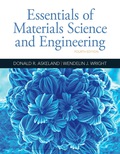
Interpretation:
The cost of material per unit volume is more important in some cases than the cost per unit weight. The cost needs to be determined in terms of
Concept Introduction:
Specific strength can be calculated as follows:
It relates the specific strengths of steel, few high strength non-ferrous alloys, and polymer- matrix composites. Additional factor to study in designing with non-ferrous material is their rate, which also differs significantly.
Explanation of Solution
Table no.1
| Metal | Density(g/ | Cost per kg($/kg) | Rank |
| Steels | 7.87 | 0.22 | 1 |
| Zinc | 7.13 | 0.88 | 2 |
| Lead | 11.36 | 0.99 | 3 |
| Aluminium | 2.70 | 1.32 | 4 |
| Copper | 8.93 | 1.57 | 5 |
| Magnesium | 1.74 | 3.31 | 6 |
| Titanium | 4.51 | 8.82 | 7 |
| Tungsten | 19.25 | 8.82 | 8 |
| Nickel | 8.90 | 9.04 | 9 |
| Beryllium | 1.85 | 777.60 | 10 |
The cost of a material per unit volume can be converted from ($/kg) to ($/g) by dividing the cost of material by 1000, and multiplying the converted cost value with density.
Table no. 2
| Metal | Density | Cost per kg | Cost per gram | Cost per volume | Rank |
| Steel | 7.87 | 0.22 | 0.22 | 0.0017 | 1 |
| Aluminium | 2.70 | 1.32 | 1.32 | 0.0036 | 2 |
| Magnesium | 1.74 | 3.31 | 3.31 | 0.0057 | 3 |
| Zinc | 7.13 | 0.88 | 0.88 | 0.0063 | 4 |
| Lead | 11.36 | 0.99 | 0.99 | 0.0013 | 5 |
| Copper | 8.93 | 1.57 | 1.57 | 0.0140 | 6 |
| Titanium | 4.51 | 8.82 | 8.82 | 0.0397 | 7 |
| Nickel | 8.90 | 9.04 | 9.04 | 0.0804 | 8 |
| Tungsten | 19.25 | 8.82 | 8.82 | 0.1696 | 9 |
| Beryllium | 1.85 | 771.60 | 771.60 | 1.4247 | 10 |
From the above two tables, the different materials are related to each other in terms of cost per kilogram and cost per volume.
Want to see more full solutions like this?
Chapter 14 Solutions
Essentials Of Materials Science And Engineering
- For the circuit shown, I-20 mA, R₁ =10000 2, R2 =2000 Q, R3 -2000 Q, R₁-6000 2, Vcc 5 V and the OPAMP is ideal with regions of operation are considered. The output current lo in mA is (choose the closet value): R₂ Is R₁ W VCC -VCC The relative tolerance for this problem is 1 %. -0.458 -0.833 6.667 -6.667 ○ 0.458 0.833 w R3 w RLarrow_forwardFor the circuit shown, let R₁-4, R2-50, R3-2, R4-77 and Vin-18. Find the current I₁ and voltage Vo as follows: Use op-amp building blocks to determine the voltage Vo1: V01 = Then use Vo1 to find the current 11: 1₁ = Find the voltage Vo: Vo= R1 www Vin R₂ ww V01 R3 The relative tolerance for this problem is 9 %. + R4 www +5°arrow_forwardFor the circuit shown, let Vs1 = 13, Vs2 = 7 R1-10, R2= 50, assume ideal-op-amp, and find • The current Is • The output voltage Vo= VSI A S R₁ ww 1 R₂ www V₁₂ + Varrow_forward
- For the circuit shown, let R₁ =16 Q, R₂ =48 2, R3 = 28 2, R4 =84 02, R5 -2002, R6 -80 2, and V₁ =4 mV. Assume ideal op-amp, find (round your answer to three digits) : Va= (MV) Vb = (MV) (mA) Vout = (MV) R₁ R₂ V₁ + R3 Vb W The relative tolerance for this problem is 7 %. ww R4 24 R5 55 R6 VOUTarrow_forward(read image) Answer: A = 1192 Narrow_forwardFor the circuit shown, find the voltage Vo and current l。. Let R₁=8, R2=1, R3-11 and V₂-3. V S (+1 || w R₂ R1 + R3 Vo The voltage Vo is: The current lo is: The relative tolerance for this problem is 3 %.arrow_forward
- (Read image) Answer:arrow_forwardFor the circuit shown, find currents 11, 12, 13, and the voltage Vo. Assume ideal op-amp, and let R₁=3, R2-40, Ro=85 and 1-6 The current I₁ is: The current 12 is: The current 13 is: The voltage Vo is: R₂ w R₁ 13 w Roarrow_forwardFor the circuit shown, let v₂ = 9, R₁=86, R2= 15, R3 =7, assume ideal-op-amp, and find • The current l₂ = • Voltage gain, Av= Vo/Vs= • The output voltage vo = A US 1+ 1. R₁ R₂ R3 10 +arrow_forward
- Show step by step solutionarrow_forwardFor the op-amp circuit shown, find the voltage Vo, and the current lo. Let R₁=8, R2=58, R3-27 and V₂-101. R1 + R₂ ww + V + The voltage Vo The current lo = = The relative tolerance for this problem is 3 % R3arrow_forward(read image) Answer: vC = 0.965 ft/sec rightarrow_forward
 MATLAB: An Introduction with ApplicationsEngineeringISBN:9781119256830Author:Amos GilatPublisher:John Wiley & Sons Inc
MATLAB: An Introduction with ApplicationsEngineeringISBN:9781119256830Author:Amos GilatPublisher:John Wiley & Sons Inc Essentials Of Materials Science And EngineeringEngineeringISBN:9781337385497Author:WRIGHT, Wendelin J.Publisher:Cengage,
Essentials Of Materials Science And EngineeringEngineeringISBN:9781337385497Author:WRIGHT, Wendelin J.Publisher:Cengage, Industrial Motor ControlEngineeringISBN:9781133691808Author:Stephen HermanPublisher:Cengage Learning
Industrial Motor ControlEngineeringISBN:9781133691808Author:Stephen HermanPublisher:Cengage Learning Basics Of Engineering EconomyEngineeringISBN:9780073376356Author:Leland Blank, Anthony TarquinPublisher:MCGRAW-HILL HIGHER EDUCATION
Basics Of Engineering EconomyEngineeringISBN:9780073376356Author:Leland Blank, Anthony TarquinPublisher:MCGRAW-HILL HIGHER EDUCATION Structural Steel Design (6th Edition)EngineeringISBN:9780134589657Author:Jack C. McCormac, Stephen F. CsernakPublisher:PEARSON
Structural Steel Design (6th Edition)EngineeringISBN:9780134589657Author:Jack C. McCormac, Stephen F. CsernakPublisher:PEARSON Fundamentals of Materials Science and Engineering...EngineeringISBN:9781119175483Author:William D. Callister Jr., David G. RethwischPublisher:WILEY
Fundamentals of Materials Science and Engineering...EngineeringISBN:9781119175483Author:William D. Callister Jr., David G. RethwischPublisher:WILEY





